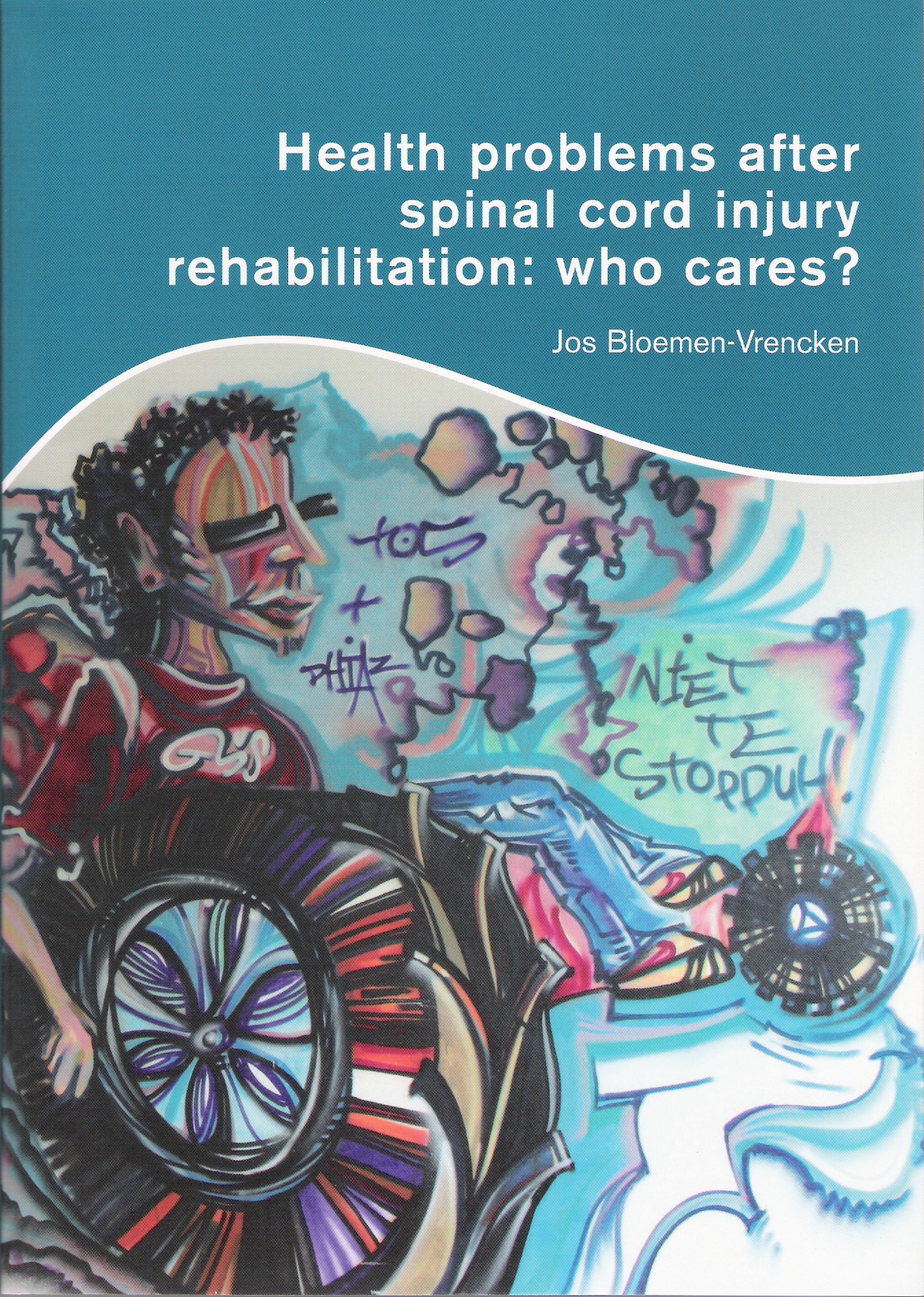Health Problems After Spinal Cord Injury
Rehabilitation: Who Cares?

Jos
Bloemen-Vrencken, MsC (Researcher)
Luc de Witte, PhD (Project leader)
Marcel Post, PhD (Project leader)

Health Problems After Spinal Cord Injury
Rehabilitation: Who Cares?
Jos Bloemen-Vrencken, MsC (Researcher)
Luc de Witte, PhD (Project leader)
Marcel Post, PhD (Project leader)

Cees Pons, MD (Project leader)
Floris van Asbeck, MD, PhD
On October 13, 2006, Jos Bloemen-Vrencken, defended her dissertation entitled:
Health problems after spinal cord injury rehabilitation: who cares?
Summary
Improvements in post-injury care and rehabilitation have eliminated or minimised many of the early complications that typically afflict those who have a new spinal cord injury (SCI). Since 1950, the life expectancy of persons with SCI has greatly increased and issues regarding long-term management have become increasingly important.
Previous research has shown that the care of persons with SCI after discharge from clinical rehabilitation is characterised by several shortcomings. The coordination and tailoring of care after discharge from clinical rehabilitation is far from perfect. Furthermore, there is very little agreement between professionals about who is primarily responsible for different aspects of care. Several studies have also illustrated that persons with SCI may experience many problems in daily life.
This thesis reports on the health problems people with SCI encounter in their daily lives once they have been discharged from rehabilitation. Furthermore, this thesis reports on an initiative to improve the follow-up care to persons with SCI after discharge from clinical rehabilitation. The proposed improvements in follow-up care are based on the nursing perspective.
The main research questions were:
What nursing problems and health problems do persons with SCI experience after discharge from clinical rehabilitation and what health behaviours do persons with SCI engage in to prevent or delay these problems?
What are relevant barriers and enabling factors for successful implementation of a transmural care model in rehabilitation practice?
What are the effects of a transmural nursing care model (and other follow-up care programmes) on the prevalence of health problems, re-admissions and the quality of follow-up care as perceived by persons with SCI?
This chapter provides background information on SCI and its prevalence, and on the care routing of persons with SCI. It also describes the research questions and presents an outline of the thesis.
This chapter reports on an explorative study into those problems of persons with SCI after discharge from rehabilitation that are within the scope of the nursing discipline (i.e. are nursing problems). The most important nursing problems appeared to be limitations in activities of daily living, having difficulties asking for help (assertiveness), pain, coping with the disability, dependence on personal help and problems with changed bladder regulation. The respondents indicated that nursing care during and after clinical rehabilitation could be improved.
This chapter describes the results of a survey assessing the prevalence of health problems among members of the Dutch Association of SCI Patients, the problems perceived as the most important ones, and the perceived impact of these most important problems on daily activities and social life.
The findings illustrate that persons with SCI living in the community experience a variety of health problems after discharge. The most frequently occurring problems regarded bladder and bowel regulation, spasms, pain, oedema and sexuality. The respondents experienced many limitations in daily activities and social life due to these problems, while pain was perceived as the most disabling condition. The occurrence of health problems did not diminish with time after the injury, which strongly underlines the need for follow-up care.
This chapter reports on the results of a descriptive study into the health behaviour of persons with SCI living in the community and the relationships between health behaviour, respondent/injury characteristics and health-related variables like the presence and number of secondary impairments.
The frequency of engaging in health behaviours varied considerably between individuals. Variance was observed between different health behaviours intended to delay or prevent secondary impairments, as well as between patients in implementing the same behaviour. The respondents do not frequently engage in pressure relief methods when sitting/driving in their wheelchairs. Hardly any statistically significant differences were observed between the health behaviours of subgroups of respondents based on respondent/injury characteristics. However, the total health behaviour scores increased significantly with increasing age, and pressure sore prevention was significantly more likely to be applied by persons with a complete lesion. Health behaviour was significantly more likely to be implemented by respondents who had one or more secondary impairments.
It was concluded that it is of great importance to rigorously test the efficacy of health behaviours promoted during rehabilitation, since education on a healthy lifestyle is a core component of every rehabilitation programme and secondary impairments are common.
This chapter describes the results of a systematic review of follow-up care programmes for persons with SCI living in the community, as implemented by rehabilitation centres. The aim of this review was to describe and compare the content of the follow-up care programmes and to assess whether there is convincing evidence for the effects of such programmes on the occurrence of secondary impairments, well-being and the quality and costs of care.
The search yielded 24 papers. The descriptions of the programmes in these papers were sometimes rather scattered, vague or brief. Five methods of follow-up care were identified: telemedicine, outpatient consulting hours, home visits, case management and mixed types of follow-up care. Sixteen programmes had been evaluated to some degree. The quality of the studies was generally poor. Most evaluations used a pre-experimental design. Only three were quasi-experimental, and two programmes used an experimental design. Although several studies claimed positive effects, it was not possible to draw conclusions on the effects of follow-up care on the occurrence of secondary impairments, well-being or the quality and costs of care.
This chapter describes the development and content of our transmural nursing care model and the results of a process evaluation of its implementation. The transmural care model was developed in cooperation with the Dutch Association of SCI Patients, community nurses, general practitioners, rehabilitation nurses, rehabilitation managers, physiatrists and researchers. The core component of the transmural nursing care model consists of a transmural nurse, who ‘liaises’ between people with SCI living in the community, primary care professionals and the rehabilitation centre. The transmural nurse is a member of the clinical rehabilitation team and is engaged for one day a week to perform four main tasks:
supporting people with SCI and their partners/families in coping with those health problems which come within the scope of the nursing discipline;
supporting primary care professionals in the specific care for people with SCI;
promoting continuity of care between primary care professionals and the rehabilitation team;
giving feedback to the rehabilitation team and taking initiatives to improve care, based on experiences with patients.
Two rehabilitation centres put the model into practice. The process evaluation showed that it was not fully implemented as planned, with a clear difference between the two rehabilitation centres. Enabling factors and barriers for implementation were found at (1) the level of the individual professionals (e.g. competencies, attitude and motivation of the transmural nurses), (2) the organisational and financial level (e.g. availability of facilities and funding) and (3) the social context (opinions of colleagues, managers and other professionals involved in the care). The most important problem experienced was that there was not enough time to put all of the activities into practice. The strength of the care model lies in the combination of supporting patients after discharge, supporting and cooperating with primary care professionals, and giving experience-based feedback to the clinical rehabilitation teams.
This chapter describes the results of the effect evaluation of our transmural nursing care model. Thirty-one participants who received transmural nursing care in two experimental rehabilitation centres were compared with a matched sample of participants having received usual follow-up care in six other rehabilitation centres. Matching was applied for level and motor completeness of the SCI, gender and age.
One year after discharge, no differences were found between the intervention and usual care groups in the prevalence of health problems (pressure sores, urinary tract infections, spasms, pain, oedema, respiratory tract infections, low blood pressure and weight increase), nor in re-admissions to hospitals and rehabilitation centres or the perceived quality of follow-up care. Since the ‘usual’ (standard) follow-up care was extended in 50% (three out of six) of the ‘control’ centres during the study period, subgroup analyses were performed between the intervention group and those participants in the control centres who did not make use of innovations in follow-up care. However, these subgroup analyses also did not show differences in outcome variables either.
This chapter presents the main results in relation to the research questions, as well as a number of methodological and theoretical considerations with regard to our studies. The chapter concludes with recommendations for rehabilitation practice and further research.
The most important conclusion is that persons with SCI may experience a variety of health problems immediately after rehabilitation, as well as in the long-term, which negatively affect their functioning. Although the need for better follow-up care is increasingly recognised, few follow-up care programmes have been described in the literature, and most of these programmes have not been evaluated properly. Therefore, there is no evidence for the effects of follow-up care programmes on the prevalence of secondary impairments, well-being or the quality and costs of care. Since our transmural nursing care model had been inconsistently and incompletely implemented in both of the ‘experimental’ rehabilitation centres and there were also several methodological and practical limitations, it was not possible to formulate final conclusions regarding its effectiveness. We feel that implementing the transmural nursing care model in a more client-centred way and applying it more strictly may both improve its effectiveness. Because health problems are common among persons with SCI living in the community, further development, implementation, evaluation and publication of follow-up care programmes for persons with SCI remains highly relevant.
Health problems of persons with spinal cord injury living in the Netherlands. Bloemen-Vrencken JH, Post MW, Hendriks JM, De Reus EC, De Witte LP. Disabil Rehabil. 27(22): 1381-9, 2005.
Health behaviour of persons with spinal cord injury. Bloemen-Vrencken JH, De Witte LP, Post MWM, Van den Heuvel WJA. Spinal Cord, 45(3): 243-9, 2007.
Transmural care in the rehabilitation sector: implementation experiences with a transmural care model for people with spinal cord injury. Bloemen-Vrencken JH, de Witte LP, Engels JP, van den Heuvel WJ, Post MW. Int J Integr Care. 2005
Comparison of two Dutch follow-up care models for spinal cord-injured patients and their impact on health problems, re-admissions and quality of care. Bloemen-Vrencken JHA, De Witte LP, Post MWM, Pons C, Van Asbeck FWA, Van der Woude LHV, Van den Heuvel WJA. Clin. Rehabil. 21(11): 997-1006, 2007.
|
|
|
 |